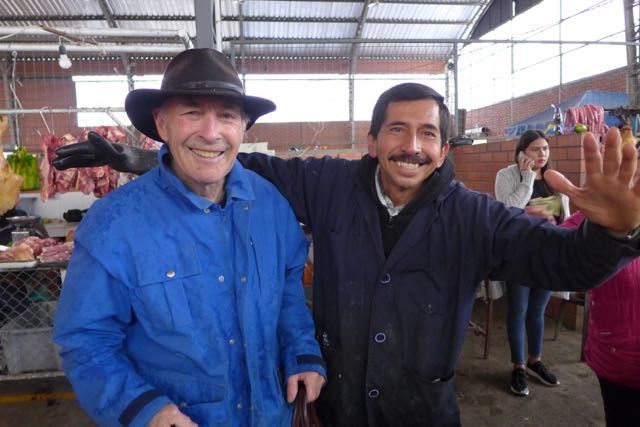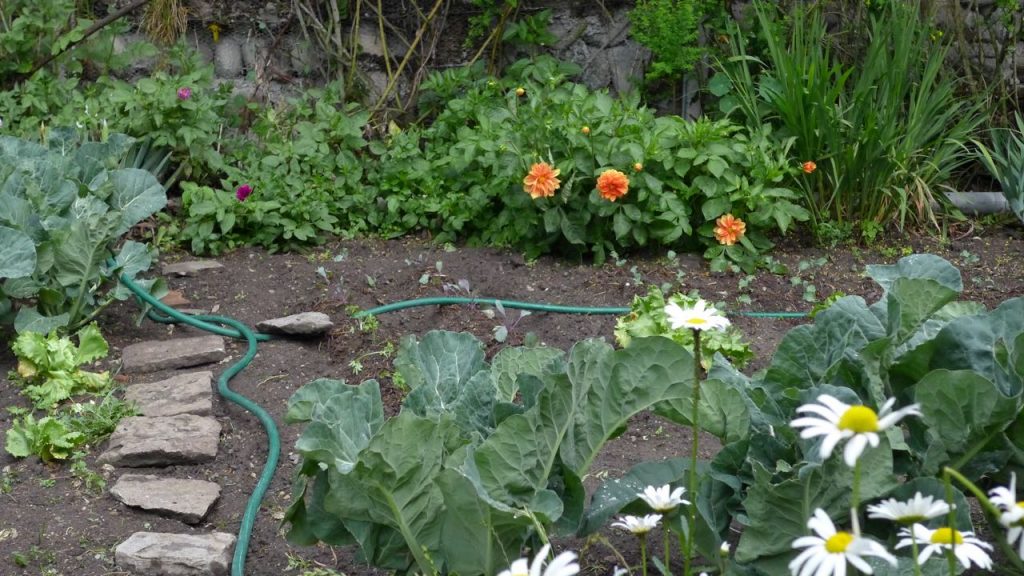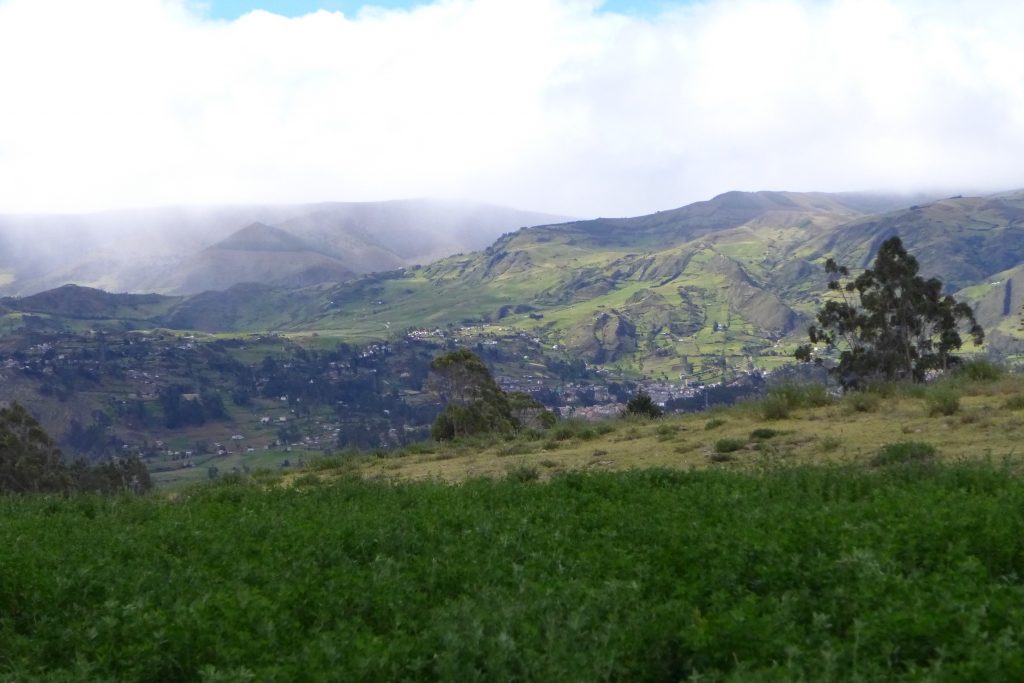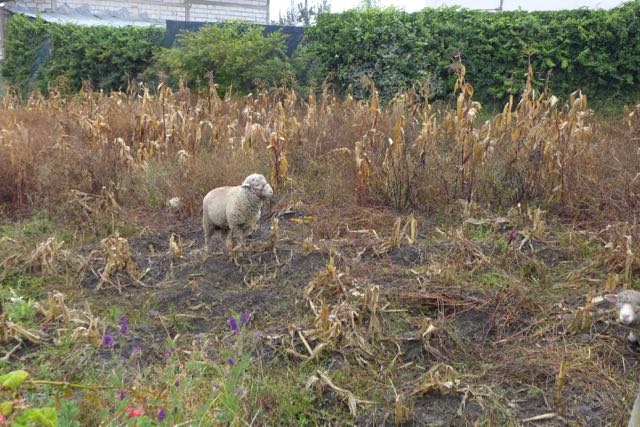We came back from Spain on June 1 to Cañar’s equatorial winter – unrelenting wind and cold and rain with night (and sometimes day) temperatures in the 40s. No heat other than the fireplace, which Michael keeps going all day now.

It might look tropical but it’s 46 degrees F (8C)

We’d forgotten that we like to be in Portland by June, but our house was firmly rented until July 1, so here we are. I’d picked up a respiratory virus the last days in Spain and the first couple of weeks here were devoted to following everyone’s home remedies: milk with garlic before bed; tea made of violets; ginger, garlic, honey and rum hot toddy; Hedera helix (ivy leaf) extract expectorant; and so on. But with a virus like this you just have to ride it out…
Meanwhile we fall back into our usual routines. Market on Sundays.


Our near neighbor Magdalena, after years of living in a near hovel with several children, is building a mega-migrant house, two-and-a-half stories flush with our property line, as is the practice here. We have tall shrubs and trees that mitigate the view somewhat, but we can only be happy that Magdalena – and it appears new daughters-in-law and babies and maybe a new son-in-law – have a house. Magdalena’s husband has been in the U.S. as long as we’ve been here. We assume. Magdalena is rather fierce with us – guardedly friendly but no exchange of information. Probably because we share a property line – a very delicate business here and we did have a few issues years back when she insisted her property line was “where the rock used to be.” But someone has obviously been sending money and Magdalena has had a pile of bricks waiting for years for this important moment in the lives of migrant families: pay off the debt, send a son or daughter, then begin saving money for a truck or house.

NOT Magdalena’s house

We see these houses everywhere – oversized, mostly badly designed, made of concrete block or brick, but the source of great pride with the family. Then they sit empty for a few years before a For Sale sign goes up. I don’t really understand all of this.`

Then there is my gardening, or my “zen” gardening as I think of it, because no matter how many weeds I pull, how much I prune, plant and plan, when I come back six months later everything has returned to its original state. The kikuyu African grass has invaded the flower beds, the fuchsia bush outside our bedroom window – that I cut back every year before we leave – is as bushy and invasive as ever. The vegetable garden, planted by our compadres who watch the house, is overpopulated with way too much cabbage, onions, cauliflower and lettuces. More than we can ever eat, and they refuse to take the produce to market, insisting it for us. So, a lot goes to waste, but before we leave, I usually do the same – plant vegetables for them (not this year, too cold!)
Another part of our agricultural cycle happens in the back field, where our compadres plant. The corn and beans are done, the field is covered in sticky weeds and two days ago we looked out to see two bulls and two sheep at work, eating all that remains. Such an efficient system! They fertilize while they eat, of course, and once the field is cleared – in a week or two – Jose María and Narcisa will till the field using the same bulls yoked to a wooden plow. And, I suspect, those same sheep will be chomping on the grass around the house while we’re gone.

Finally, this particular June will be memorable because, after 18 months of frustrating paperwork, innumerable trips to Cuenca and Azogues (regional capital) to a horrible building called “Center of Citizen Attention (see above image), several moments of my head-on-desk in front of a government agent – “no es possible…” when I was turned down once again because of an error made 10 years ago at an airport in my passport, or a mistaken date in an office in Quito – I HAVE A NEW VISA! I didn’t cry during the process, which has taken such a chunk out of my time here in 2018 and 2019, though I was tempted at times. When I told the agent this past week that this has been the worst experience of my 15 years living in Ecuador, she didn’t blink. Then, because it had just happened as I was waiting, I said – “And a man just walked by sobbing!” “That’s different,” she said, “he’s from Venezuela,” as though that made a difference. (There has been a huge waves of Venezuelans coming to Ecuador, trying to work and make new lives.)
Anyway, three days ago I had my last interview when I knew I’d cleared all the hurdles. I gave the agent my two passports, old and new. She asked me to go into the waiting room while she processed the visa. I asked if I could observe. No. She called me back in a few minutes, handed my the passports and said, “Your visa is in an email.” I couldn’t believe it. Do I stick it in my passport? I asked. “No, no just carry the paper with you as you leave and come into the country.” Here it is

An interesting update to my last post about the Jewish community in Gerona, Spain from my favorite daily blog, Spitalfields Life. “Built in 1901, the Bevis Marks Synagogue in London is the oldest synagogue in the UK, and it has been continuously in use for over three hundred years, … Its origin lies with Spanish and Portuguese Jews who came to London in the seventeenth century, escaping persecution of the Catholic Church and taking advantage of a greater religious tolerance in this country under Oliver Cromwell’s rule. When war broke out between England and Spain in 1654, Antonio Robles, a wealthy merchant, went to court to prove that he was Jewish rather than Spanish – establishing a legal precedent which permitted Jewish people to live freely in this country for the first time since their expulsion by Edward I in 1290.”
The Cañar Book Club

Coming back from Spain, my worst reader’s fears were realized when I saw I was out of books. I had loaded one on my mini-iPad for the trip – my first ever ebook – and I turned back to that source out of desperation. That took me down the rabbit-hole of Amazon’s 1-click buy (click-bait?) and I haven’t stopped ordering books since, and reading at a much faster pace, for some reason (partly, all the bus reading time for visa business). So, graded by stars: The Hand that Held Mine, Maggie O’Farrell (****), West by Cary Davies (***), Educated by Tara Westover (****), The Great Believers, Rebecca Makkai (**), Anything is Possible by Elizabeth Strout (****), and The Friend by Sigrid Nunez (*). This was getting expensive and I had to stop. It occured to me I could order ebooks from my home library and I put in a couple of titles. Normal People by Sally Rooney – over 500 holds!
So, now I’m back to re-reading “paper” books from my Cañar shelves, The Story of Lucy Gault by William Trevor, a favorite author, and My Name is Lucy Barton by Elizabeth Strout, a prequel to Anything is Possible. Those’ll take me home to Portland, next week, June 30, when I’ll start stockpiling books for next year’s trip to Ecuador.
Meanwhile, some faithful book club members have stayed active through June. Here are their comments.
Irene from Salem sent my all-time favorite title:. The Gentle Art of Swedish Death Cleaning. Author?
Maggi Redmonds from Toronto: The End of Days: A Story of Tolerance, Tyranny and the Expulsion of the Jews from Spain, by Erna Paris,
Patty in Portland: The Book of Unknown Americans by Cristina Henriquez and Go, Went, Gone by Jenny Erpenbeck.
Joanne in Portland read The Great Believers on the plane back from Philly and loved it; also started The Ninth Hour – a bit dark but excellent writing. Before that she read Say Nothing, which was really compelling and she loved Milkman. (Not everyone does.) And like me and hundreds of others, she’s on the list at the library for both of Sally Rooney’s novels.
Mel in Vermont is reading Michael Ondaatje’s Cat’s Table.
My sister Sherry in Santa Fe: reading the best book! The Night Of The Gun by David Carr
Who sent this? I’m sorry to say I lost track, but it goes so beautifully with my previous post and the update above. The Weight of Ink, by Rachel Kadish. This is about descendants of Portuguese Jews who escaped the inquisition by moving to Britain, and how modern-day researchers uncovered this history through 17th century manuscripts found in an English home.
Fond regards to all.





So glad the visa is finally sorted Judy, and now it sounds like you’re ready to head home to Portland and, hopefully, some warm weather!
Re Book Club; Normal People is good, very readable but not as outstanding as all the hype would have you believe. Much much better is “Eleanor Oliphant is completely fine” by Gail Honeyman. Can’t remember whether I mentioned it before but it’s The Best Book Ever (a large but nevertheless exclusive category). I’m about to embark on Madeline Miller’s Circe which is being raved about here in the UK, having just finished another magnificent Maggie O’Farrell – “The Disappearing Act of Esme Lennox” which was wonderful. I shall report back. Would love to know more about what you thought of West.
Hello Judy, we are called too in Uzhupud near Paute. If you want to read a good book about gardening and wild spaces I recommend “The Gardening Awakening” by Mary Reynolds. It will make you feel better about your garden being taken over by wild plants.
Magdalena (not your neighbor)
Looking forward to your return in July. Jon and I have missed you two.
Another sweet read is by the artist and author Emily Carr. “Growing Pains:An Autobiography”. She lived from 1871 to 1945. She is one of my favorite artists.
The Hour of Land by Terry Tempest Williams. If you haven’t already read it, I know you would like it. It’s been too long – I would love to see you.
June was SO cold in Ecuador! Hang in there. Also, the McMigrantMansions: where do you think they get the ideas for design? American TV? I’m currently begrudgingly reading The Great Believers for book club and resenting it. The only likable character is the protagonist which makes me distrust the writing.
Jude, loved your missive as always.
The first photo is wonderful and says so much about your “adopted”
“country” of Cañar. Friends and compadres! All the pageantry that mark the
course of a year. Your insightful and creative documentation of their disappearing ways . And now the dreadful mansions dotting the green hills, empty and useless,
but who are we to dislike these symbols of the ‘good life”. We’ve just grown
used to them here! I know you’re almost ready to return to Portland. Have to
say, I’m loving being back in Santa Fe. Summer!
I just got City of Girls …Elizabeth Gilbert. I like her. Will comment on the next book club. Love , Char
Hi Judy,
You’re almost in Portland. Stay strong. A book about/by a strong woman is “Temperance Creek” by Pamela Royes. She runs off with a man who lives wild in Hell’s Canyon. She survives sheep herding, living in a canvas tent with no amenities in all weather. Of course, she’s nineteen at the time, but the book is written from the perspective of her mature self. See you this summer. Pat
and here you are in Portland – just in time for the Naked Bike Ride – I’m sure you and Michael were part of the 10,000 who rode through NE Portland! I have extra garden slugs and I think I might bring some by – along with the leaves they’ve enjoyed of Hosta, Broccoli, Beets, Chard…
We were in SF last month and stayed across the street from City Lights Bookstore…and perusing the shelves I saw and have read, Washington Black, by Esi Edugyan. Fabulous, upsetting, intense – young slave from the Caribbean islands in taken away and “raised” by white eccentric.